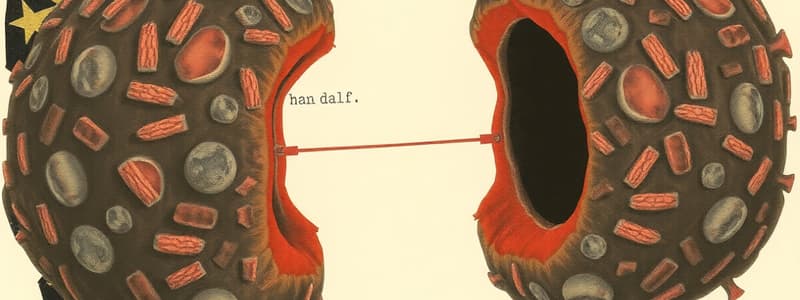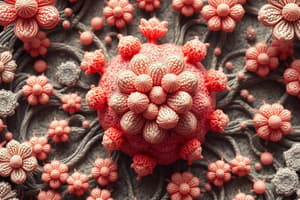Podcast
Questions and Answers
Which term describes an increase in cell number due to stimulation of cell division?
Which term describes an increase in cell number due to stimulation of cell division?
- Metaplasia
- Hyperplasia (correct)
- Atrophy
- Hypertrophy
Dysplasia refers to a normal arrangement and structure of cells.
Dysplasia refers to a normal arrangement and structure of cells.
False (B)
What are two main types of cell death?
What are two main types of cell death?
Apoptosis and Necrosis
In response to a severe and persistent stimulus, cells may undergo ________ and potentially die.
In response to a severe and persistent stimulus, cells may undergo ________ and potentially die.
Match the following terms with their definitions:
Match the following terms with their definitions:
What is a common outcome when the cell's adaptability is exceeded?
What is a common outcome when the cell's adaptability is exceeded?
Adaptations in cells are permanent changes that cannot revert to a normal state.
Adaptations in cells are permanent changes that cannot revert to a normal state.
Cellular homeostasis requires cells to maintain physiological parameters such as ________, temperature, and oxygenation.
Cellular homeostasis requires cells to maintain physiological parameters such as ________, temperature, and oxygenation.
What type of cells are continuously dividing in adult life?
What type of cells are continuously dividing in adult life?
Stable cells divide infrequently but can rapidly divide if necessary.
Stable cells divide infrequently but can rapidly divide if necessary.
Define hypertrophy.
Define hypertrophy.
____________ is characterized by an increase in the number of cells within a tissue.
____________ is characterized by an increase in the number of cells within a tissue.
Match the following types of hyperplasia with their examples:
Match the following types of hyperplasia with their examples:
Which of the following is NOT a cause of atrophy?
Which of the following is NOT a cause of atrophy?
Permanent cells can divide but only to a clinically significant level.
Permanent cells can divide but only to a clinically significant level.
What term describes the adaptive response where squamous epithelium changes to glandular epithelium in reflux esophagitis?
What term describes the adaptive response where squamous epithelium changes to glandular epithelium in reflux esophagitis?
Atrophy involves the self-digestion of organelles by a process known as ____________.
Atrophy involves the self-digestion of organelles by a process known as ____________.
What could lead to pathological hypertrophy?
What could lead to pathological hypertrophy?
What can heat exposure lead to in cells?
What can heat exposure lead to in cells?
Ischaemia is caused exclusively by physical agents such as heat and cold.
Ischaemia is caused exclusively by physical agents such as heat and cold.
What is the main hazard posed by excessive alcohol metabolism in cells?
What is the main hazard posed by excessive alcohol metabolism in cells?
Chemical injuries can involve disruption of biochemical reactions or compromises to the ________.
Chemical injuries can involve disruption of biochemical reactions or compromises to the ________.
Match the type of cold-related injury with its consequence:
Match the type of cold-related injury with its consequence:
Which of the following describes the condition known as hypoxia?
Which of the following describes the condition known as hypoxia?
Ischaemia is considered a less severe condition compared to hypoxia.
Ischaemia is considered a less severe condition compared to hypoxia.
What is the main consequence of severe and prolonged cellular stress?
What is the main consequence of severe and prolonged cellular stress?
Ischaemia involves a problem with ____ supply.
Ischaemia involves a problem with ____ supply.
Match the causes of cell injury with their descriptions:
Match the causes of cell injury with their descriptions:
Which of the following is NOT a type of cellular injury?
Which of the following is NOT a type of cellular injury?
Apoptosis and necrosis are two forms of cell death.
Apoptosis and necrosis are two forms of cell death.
Name one scenario that can lead to hypoxia.
Name one scenario that can lead to hypoxia.
What is the main outcome of apoptosis?
What is the main outcome of apoptosis?
Endotoxins are released by living bacteria.
Endotoxins are released by living bacteria.
What vitamin deficiency is associated with scurvy?
What vitamin deficiency is associated with scurvy?
In excessive nutritional conditions, Vitamin A toxicity can cause __________ problems.
In excessive nutritional conditions, Vitamin A toxicity can cause __________ problems.
Match the immune response with its effect:
Match the immune response with its effect:
Which of the following is a characteristic of necrosis?
Which of the following is a characteristic of necrosis?
Neutrophils in the innate immune response can destroy normal tissue during infections.
Neutrophils in the innate immune response can destroy normal tissue during infections.
What is the primary cause of cell injury in allergic reactions?
What is the primary cause of cell injury in allergic reactions?
Which type of necrosis is characterized by tissue being replaced by liquefied material?
Which type of necrosis is characterized by tissue being replaced by liquefied material?
Coagulative necrosis typically occurs due to ischaemic injuries.
Coagulative necrosis typically occurs due to ischaemic injuries.
What pathological condition is associated with caseous necrosis?
What pathological condition is associated with caseous necrosis?
Fat necrosis is associated with breakdown of _______ cells.
Fat necrosis is associated with breakdown of _______ cells.
Match the following terms with their descriptions:
Match the following terms with their descriptions:
What is a common characteristic of fibrinoid necrosis?
What is a common characteristic of fibrinoid necrosis?
Fat necrosis involves the leakage of fatty acids that bind to calcium.
Fat necrosis involves the leakage of fatty acids that bind to calcium.
What type of necrosis is exclusively seen in the brain due to lack of tissue architecture?
What type of necrosis is exclusively seen in the brain due to lack of tissue architecture?
Flashcards are hidden until you start studying
Study Notes
Cellular Adaptations
- Cells adapt to changes in their environment to preserve cell viability
- Adaptations are reversible changes in cells in response to physiological or pathological conditions
- Adaptations can involve changes in cell number, size, and type
- Three classes of cell proliferative capacity: labile, stable, and permanent cells
- Labile cells are continuously dividing
- Stable cells are infrequent dividers but can divide rapidly when needed
- Permanent cells never divide in adult life
Hyperplasia
- Increase in the number of cells within a tissue
- Only occurs in labile or stable cells
- Physiological hyperplasia occurs due to hormonal stimulation (e.g. endometrium) or compensatory mechanisms (e.g. partial hepatectomy)
- Pathological hyperplasia is caused by excessive hormone or growth factor stimulation or chronic irritation
- Pathological hyperplasia can be associated with an increased risk of tumor development
Hypertrophy
- Increase in cell size
- Occurs in any cell, but is common in permanent cells due to increased demands
- Physiological hypertrophy occurs due to increased functional demand (e.g. skeletal muscle) or hormonal/growth factor stimulation (e.g. uterine muscle in pregnancy)
- Pathological hypertrophy occurs due to increased functional demand (e.g. cardiac muscle in hypertension or aortic stenosis)
Atrophy
- Shrinkage in cell size by loss of cell substance through the process of autophagy
- Causes of atrophy include reduced workload, loss of nerve supply, reduced blood supply, inadequate nutrition, loss of endocrine stimulation, and ageing
Metaplasia
- Transformation of one cell type to another cell type
- Physiological metaplasia is a normal part of growth and development
- Pathological metaplasia is an adaptive response to an abnormal environment (e.g. squamous to glandular epithelium in reflux oesophagitis)
Cellular Injury and Stress
- Cellular Stress triggers various responses:
- Adaptation: Reversible changes, cell adjusting to stress
- Injury: Reversible or irreversible, depending on severity and duration
- Cell Death: The final outcome if injury is severe or prolonged
- Causes of Cell Injury and Death:
- Oxygen Deprivation (Hypoxia): Impairs aerobic metabolism, leading to cell injury
- Ischemia: Reduced blood supply causes more severe injury than simple hypoxia.
- Nutrition Imbalances: Deficiencies or excesses can disrupt cell function.
- Physical Agents:
- Heat: Can coagulate and damage proteins, leading to cell death.
- Cold: Can cause vasoconstriction, ice crystal formation, and tissue damage.
- Electricity: Can disrupt cell membranes and electrical activity (e.g., cardiac arrhythmias).
- Chemicals and Drugs:
- Direct Damage: Some chemicals can directly disrupt cellular processes.
- Metabolic Breakdown Products: Some chemicals become toxic after metabolic degradation.
- Osmotic Disruption: Chemicals can alter the cell's water balance.
- Interference with Biochemical Reactions: Chemicals can disrupt essential metabolic pathways
- Infectious Agents:
- Viruses: can take over the cell's machinery for their own replication.
- Bacteria: can cause direct damage (endotoxins, exotoxins) and indirect damage (immune responses).
- Immune Reactions:
- Allergies: Hypersensitivity reactions can cause tissue damage.
- Autoimmune Diseases: Immune system attacks the body’s own tissues.
- Oxygen Deprivation (Hypoxia): Impairs aerobic metabolism, leading to cell injury
Types of Cell Death
- Apoptosis: Programmed cell death, internally controlled, often a normal process.
- Physiological: E.g., embryological development, tissue involution, removal of damaged lymphocytes.
- Pathological: E.g., DNA damage, cell stress, infections.
- Necrosis: Unprogrammed cell death, caused by external injury, characterized by inflammation and leakage of cell contents.
- Coagulative: Cells retain their structure, common in ischaemic injuries (except the brain).
- Liquefactive: Tissues become liquefied (often due to enzymatic digestion).
- Caseous: Characteristic of tuberculosis, cheese-like appearance.
- Fat: Breakdown of fat cells with fatty acid leakage, often associated with pancreatitis.
- Gangrenous: Necrosis of a limb involving coagulative and sometimes liquefactive necrosis.
- Fibrinoid: Occurs in vessel walls due to immune complexes, often seen in vasculitis.
Studying That Suits You
Use AI to generate personalized quizzes and flashcards to suit your learning preferences.




